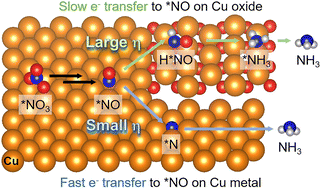Identifying the active sites and intermediates on copper surfaces for electrochemical nitrate reduction to ammonia†
Abstract
Copper (Cu) is a widely used catalyst for the nitrate reduction reaction (NO3RR), but its susceptibility to surface oxidation and complex electrochemical conditions hinders the identification of active sites. Here, we employed electropolished metallic Cu with a predominant (100) surface and compared it to native oxide-covered Cu. The electropolished Cu surface rapidly oxidized after exposure to either air or electrolyte solutions. However, this oxide was reduced below 0.1 V vs. RHE, thus returning to the metallic Cu before NO3RR. It was distinguished from the native oxide on Cu, which remained during NO3RR. Fast NO3− and NO reduction on the metallic Cu delivered 91.5 ± 3.7% faradaic efficiency for NH3 at −0.4 V vs. RHE. In contrast, the native oxide on Cu formed undesired products and low NH3 yield. Operando shell-isolated nanoparticle-enhanced Raman spectroscopy (SHINERS) analysis revealed the adsorbed NO3−, NO2, and NO species on the electropolished Cu as the intermediates of NH3. Low overpotential NO3− and NO adsorptions and favorable NO reduction are key to increased NH3 productivity over Cu samples, which was consistent with the DFT calculation on Cu(100).

- This article is part of the themed collection: Most popular 2024 energy & environmental chemistry articles


 Please wait while we load your content...
Please wait while we load your content...